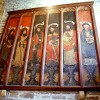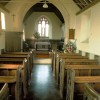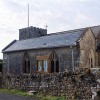The Victoria Cross is the highest military decoration awarded for valour in the face of the enemy. The second Dorset man to be awarded the medal was William George Hawtry Bankes of Kingston Lacy, who was born here on the 11th of September 1836. He was the fifth child born to George Bankes M.P. and Georgina Charlotte Nugent. Educated at Temple Grove, a preparatory school established in 1810 but still in existence today, Bankes later went on to Westminster School.
According to regimental sources his joining the military probably had more to do with keeping in touch with his friends; it seems he displayed little enthusiasm for a career as an officer. Nevertheless, on the 3rd of March 1857 William Bankes was commissioned as a Cornet in the 7th Queen’s Own Regiment of Light Dragoons (Hussars). The regiment left for India aboard the clipper Lightning on the 27th August 1857 and arrived at Calcutta on the 25th of November after an 88 day voyage; the regiment disembarked on the 1st of December and moved to Fort William.
From Fort William the 7th Hussars moved to Rannegaige, arriving in mid-December. In a letter home William commented that the terrain looked very similar to that of Studland Heath in Dorset. From here they moved on foot some seventy miles to Allhabad, the officers being carried in palaquins. Here horses had been acquired by an advance party who had travelled to India earlier. William Bankes reported that it took only two weeks to break in the horses, a remarkably short time. The Regiment set off on horseback to Cownpore and then on to Lucknow.
Regimental records show the 7th Hussars were in active service, escorting convoys from Cownpore to Lucknow between the 4th and 24th of February. The regiment was present and actively involved throughout the operation involving the siege and relief of Lucknow.
The record of these events says : ”On the 19th (March) in a skirmish near Moosa-Bagh, Capt. Slade and Lieut. Wilkin were severely wounded. Cornet W.G. Bankes mortally and two men mounded. The latter officer (Bankes) particularly distinguished himself when Capt Slade was wounded, by gallantly leading the troop and thrice charging a body of infuriated fanatics, who had rushed on the guns employed on shelling a small mud fort, killing three of the enemy with his own hand, and receiving 11 wounds of which he afterwards died, He was awarded the V.C. for his gallantry on this occasion”.
Cornet Bankes was seriously wounded during the attack on Moose-Abagh. He was moved to the military hospital where he had his right arm and right leg amputated by the Surgeon, General Sir Colin Campbell. His Commanding Officer, Colonel Hagart, and Sir Colin Campbell, both wrote letters to his parents informing them of his condition from which he was expected to recover but on the 6th of April 1858 he died from an infection to his wounds. There is an account of his condition at the field hospital. It reads (giving the condition of William Bankes): “… one leg is lopped off above the knee; the other is nearly severed; one arm is cleft to the bone; the other has gone entirely, and about the body are many slashes. When Dr. Russell went to see him afterwards, the brave youngster was quite cheerful and is reputed to have said ‘they tell me, if I get over this I can go yachting…” We believe the Dr Russell referred to is the war correspondent William Howard Russell; he certainly covered the Indian Mutiny for The Times.
As life deserted William Bankes, Queen Victoria wrote of him in a letter to the Princess Royal: “There is a poor young man, of the name Bankes, who has been cut almost to pieces, he fell and was surrounded by a set of fanatics who cut at him, his thigh was nearly severed from his body, and so was his arm! Besides six other desperate wounds! He has had his right leg and his right arm amputated, and yet they hope he will live. This is, they say, the pattern of patience and fortitude”. Later Queen Victoria presented the award to his mother at Kingston Lacy; it is now on display at The Queen’s Own Hussars Museum.
His fellow officers placed a memorial plaque in Wimborne Minster commemorating their fallen comrade. In St. Nicholas Church at Studland there is a stained glass window to his memory and in Westminster Abbey, at the west end of the North Transept, there is a memorial window dedicated to him.



